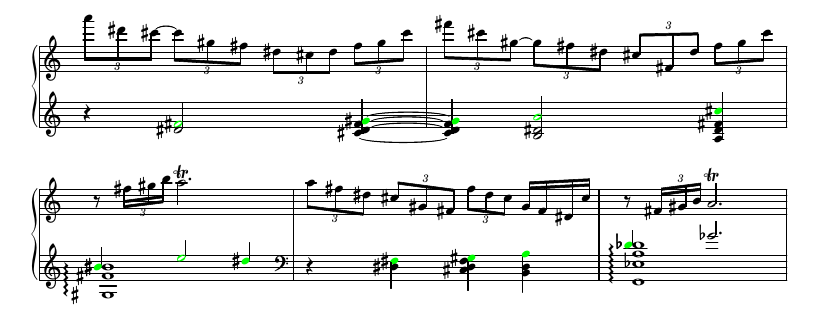Rachmaninoff Piano Concerto No. 1 - A Review
Rachmaninoff's 2nd1 and 3rd2 piano concertos get all the love, but what about his first? I've listened to it a few times but either it's not very memorable or I wasn't paying close enough attention. For my 2nd 2022 music project I thought it would be fun to listen to it more closely. Like it was my school assignment to do so.
Sometimes these things sound more fun in my head. But now I'm in too deep, so off we go.
1st Movement
Like most Rachmaninoff and/or late-Romantic pieces, there's a lot of chromatics. The main theme is pretty rich harmonically, which I've notated below.
Nothing truly crazy, but I thought the modulation progression from F♯m → G♯7 → C♯m → D♯7 and then moving backward to C#m by way of G♯7 (instead of the more natural G♯m) was neat. And then using the G♯ as a pedal tone around the Bm6 to eventually resolve to C#7 was also neat. It's very satisfying and natural. Kinda reminiscient of the third concerto (or vice versa, I guess) with a simple main theme with some meandering chromatics and then eventually resolving to V7 - i.
Another interesting thing I noticed in the first movement was during the cadenza. In true Rachmaninoff form, there are lots of notes and block chords, but this cadenza features a lot of modulations. Within some of these modulations are references to the main theme (as shown above, highlighted in green below):
However, I don't completely understand the reason for the oddly spelled and seemingly out of place F7 chord in the last bar. Obviously the D♭ enharmonic finishes the last note of the first measure of the main theme, but I don't even understand why Rachmaninoff put an F7 chord under what's clearly an arpeggiated F♯m6 run (ending with the trill on A).
The only thing I could think of is that a few bars later it changes keys to D♭, so maybe the F7 chord is setting up the (eventual) key change: F7 is the V of B♭ minor which is the relative minor of D♭... meh, seems a stretch to me.
2nd Movement
Another interesting spelling choice:
I assume this is just for readability (it might be an editor's choice, since the last measure of this example was the first measure after a page turn), but given the fact that the left hand switches clefs and still ends up on E♭ makes this choice a little puzzling.
3rd Movement
The third movement seems a little bipolar. Starts off hot and spicy, in stark contrast to the typically slow 2nd movement. Then after a hot-and-spicy minute, it slows way down following the most jarring key change transition of all time.
This slow section ends the exact same way the 2nd movement ends, just a half-step up (E♭ instead of D). Then it's a bunch of frantic and fast-paced, almost march-like segments until the coda, and it ends with a flourish.
Overall, not a bad movement, but the transition between the slow and fast parts was too extreme and out of left field. But I'm not a legendary virtuoso composer, so maybe Rachmaninoff knows better than me.
I did enjoy this brief tremolo that reminded me of the 3rd movement of Rachmaninoff's 3rd concerto:
Concluding thoughts
It's a good concerto, but it's pretty clear why the other two are so much more famous. Seems like he got out all of the kinks by the time the 2nd concerto rolled around, and everything was much more smooth and polished.
If I had to rank the movements, I'd say they go in order from best to worst: 1, 2, 3. The 1st movement starts and ends strong, and has a fantastic cadenza. The 2nd movement is moving, slow and atmospheric and sets the mood. The 3rd movement starts strong but gets weird with tempo changes, key changes and mood changes. Overall they are all nice to listen to.
To write this article I listened to a a performance by Anna Fedorova and followed along with the full score. As usual, it made me painfully aware how utterly inept I am at reading Alto clef.
As usual, I used Lilypond to transcribe the passages used in this article. You can download my (very messy) Lilypond file here.
- I like Yuja Wang's interpretation best
- Arcadi Volodos does a great ossia cadenza, and Yuja Wang does a great non-ossia cadenza





